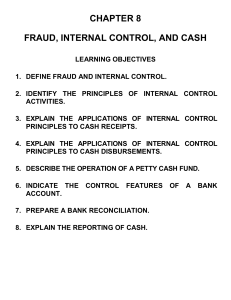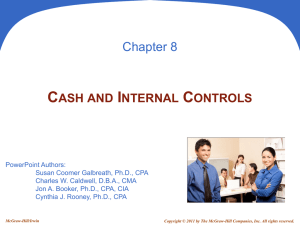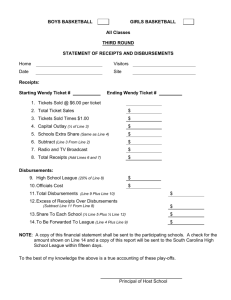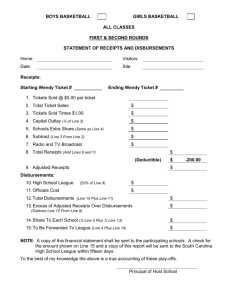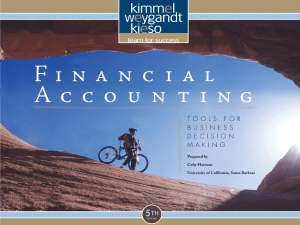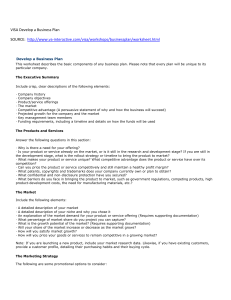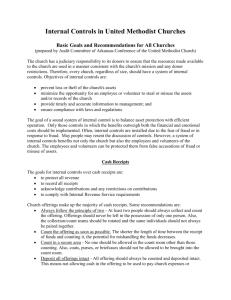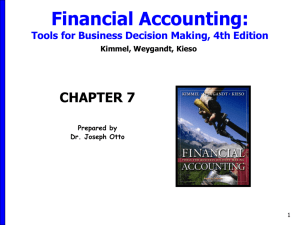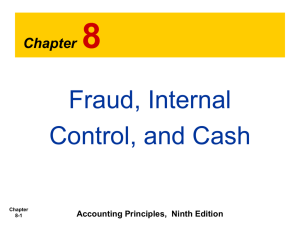Financial Accounting and Accounting Standards
advertisement
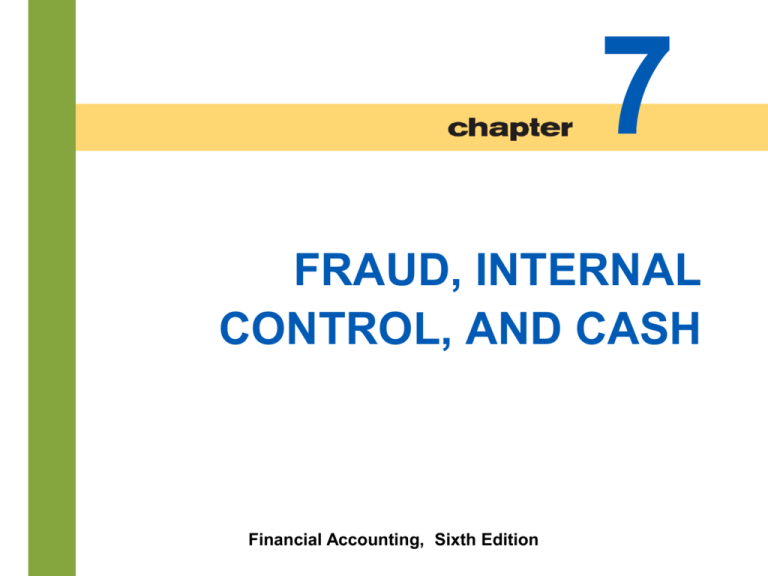
7 FRAUD, INTERNAL CONTROL, AND CASH 7-1 Financial Accounting, Sixth Edition Study Objectives 7-2 1. Explain the applications of internal control principles to cash disbursements. 2. Prepare a bank reconciliation. 3. Explain the reporting of cash. Fraud and Internal Control The Sarbanes-Oxley Act (aka SOX) 7-3 All publicly traded U.S. corporations are required to maintain an adequate system of internal control. Corporate executives and boards of directors must ensure that these controls are reliable and effective. Independent outside auditors must attest to the adequacy of the internal control system. SOX created the Public Company Accounting Oversight Board (PCAOB). SO 1 Define fraud and internal control. Fraud and Internal Control Internal Control Methods and measures adopted to: 7-4 1. Safeguard assets. 2. Enhance accuracy and reliability of accounting records. 3. Increase efficiency of operations. 4. Ensure compliance with laws and regulations. SO 1 Define fraud and internal control. Fraud and Internal Control Principles of Internal Control Activities Establishment of Responsibility Control is most effective when only one person is responsible for a given task. Segregation of Duties Related duties should be assigned to different individuals. Documentation Procedures Companies should use prenumbered documents and all documents should be accounted for. 7-5 SO 2 Identify the principles of internal control activities. Fraud and Internal Control Principles of Internal Control Activities Illustration 7-2 Physical Controls 7-6 SO 2 Identify the principles of internal control activities. Fraud and Internal Control Principles of Internal Control Activities Independent Internal Verification 1. Records periodically verified by an employee who is independent. 2. Discrepancies reported to management. Human Resource Controls 1. Bond employees. 2. Rotate employees’ duties and require vacations. 3. Conduct background checks. 7-7 SO 2 Identify the principles of internal control activities. Fraud and Internal Control Limitations of Internal Control 7-8 Costs should not exceed benefit. Human element. Size of the business. SO 2 Identify the principles of internal control activities. 7-9 Cash Controls Cash Receipts Controls Illustration 7-4 7-10 SO 3 Illustration 7-5 Cash Receipts Controls Over-the-Counter Receipts Important internal control principle— segregation of record-keeping from physical custody. 7-11 SO 3 Explain the applications of internal control principles to cash receipts. Cash Receipts Controls Mail Receipts: 7-12 Mail receipts should be opened by two people, a list prepared, and each check endorsed “For Deposit Only”. Each mail clerk signs the list to establish responsibility for the data. Original copy of the list, along with the checks, is sent to the cashier’s department. Copy of the list is sent to the accounting department for recording. Clerks also keep a copy. SO 3 Explain the applications of internal control principles to cash receipts. Cash Controls Cash Disbursements Controls Generally, internal control over cash disbursements is more effective when companies pay by check, rather than by cash. Applications: 7-13 Voucher system Petty cash fund SO 4 Explain the applications of internal control principles to cash disbursements. Cash Controls Cash Disbursements Controls Illustration 7-6 7-14 SO 4 Cash Controls Cash Disbursements Controls Illustration 7-6 7-15 SO 4 Cash Controls Cash Disbursements Controls Voucher System 7-16 Network of approvals, by authorized individuals, to ensure all disbursements by check are proper. A voucher is an authorization form prepared for each expenditure. SO 4 Explain the applications of internal control principles to cash disbursements. Cash Controls Cash Disbursements Controls Petty Cash Fund - Used to pay small amounts. Involves: 1. establishing the fund, 2. making payments from the fund, and 3. replenishing the fund. 7-17 SO 4 Explain the applications of internal control principles to cash disbursements. Control Features: Use of a Bank Contributes to good internal control over cash. 7-18 Minimizes the amount of currency on hand. Creates a double record of bank transactions. Bank reconciliation. Control Features: Use of a Bank Illustration 7-7 Bank Statements Debit Memorandum Bank service charge NSF (not sufficient funds) Credit Memorandum 7-19 Collect notes receivable. Interest earned. Control Features: Use of a Bank Reconciling the Bank Account Reconcile balance per books and balance per bank to their adjusted (corrected) cash balances. Reconciling Items: 1. Deposits in transit. 2. Outstanding checks. Time Lags 3. Bank memoranda. 4. Errors. 7-20 SO 5 Prepare a bank reconciliation. Control Features: Use of a Bank Reconciliation Procedures Illustration 7-8 + Deposit in Transit + Notes collected by bank - - NSF (bounced) checks - Check printing or other service charges Outstanding Checks +/- Bank Errors +/- Book Errors CORRECT BALANCE 7-21 CORRECT BALANCE SO 5 Prepare a bank reconciliation. Control Features: Use of a Bank Electronic Funds Transfers (EFT) 7-22 Disbursement systems that uses wire, telephone, or computers to transfer cash balances between locations. SO 5 Prepare a bank reconciliation. Reporting Cash Most liquid asset, listed first. Illustration 7-11 Cash equivalents 7-23 Restricted cash SO 6 Explain the reporting of cash.

